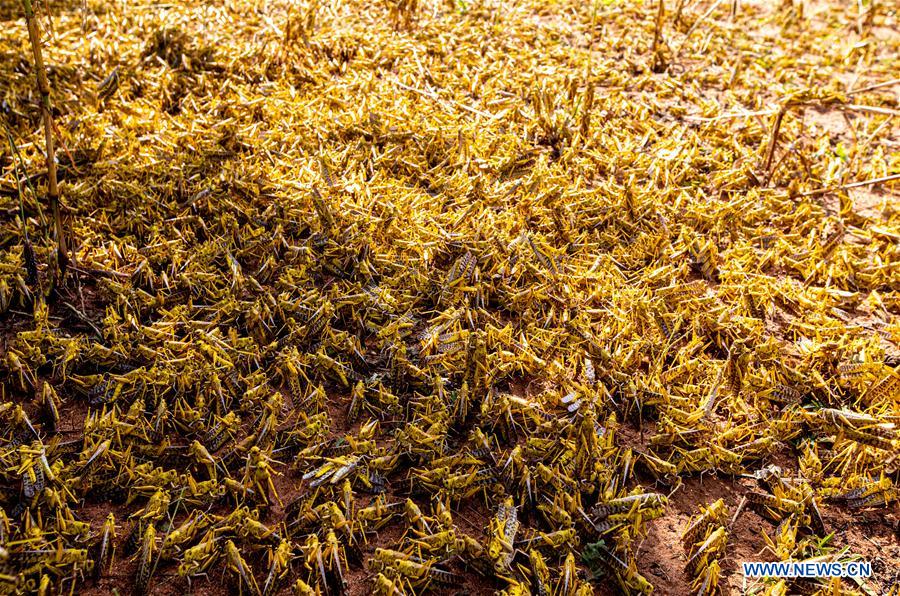UN says desert locust situation remains 'extremely alarming' in east Africa
 0 Comment(s)
0 Comment(s) Print
Print E-mail Xinhua, February 26, 2020
E-mail Xinhua, February 26, 2020

The United Nations Food and Agriculture Organization (FAO) on Tuesday stressed that the desert locust outbreak situation has remained "extremely alarming" in the Horn of Africa (HoA), posing serious food security threat across Ethiopia, Somalia and Kenya.
"The desert locust situation remains extremely alarming in the Horn of Africa, specifically Kenya, Ethiopia and Somalia where widespread breeding is in progress and new swarms are expected to form in the coming weeks," the FAO said in its desert locust outbreak update issued Tuesday.
According to the FAO, the desert locust situation in Ethiopia "is similar to Kenya with widespread swarms, breeding and hatching in Somali, Oromiya and Southern regions, including the Rift Valley."
"Movements further north can be expected as well as from adjacent areas of Somalia and Kenya," the FAO warned.
In Kenya, desert locust swarms have continued to be reported in northern and central areas, where they are mostly mature and have laid eggs.
"Hatching is causing an increasing number of hopper bands to form with new swarm formation expected in the coming weeks in Kenya," the FAO said, adding that mature desert locust swarms are also present along the shores of Lake Turkana amid the continued aerial and ground control operations.
The FAO also stressed that desert locust breeding has continued in Somalia's northeastern part, where new immature swarms are expected to form in about one week or so.
It also noted that mature desert locust swarm has arrived in the northeastern Uganda from adjacent areas of western Kenya on Feb. 24.
In South Sudan, only remnants of an earlier mature swarm have been seen in the southeastern county of Magwi, while a second mature swarm was seen near the border on Feb. 23, it was noted.
The FAO, however, said that no new desert locust swarms were reported in Tanzania.
It also indicated that a small group of mature desert locust has arrived in the Democratic Republic of the Congo (DRC)'s western shore of Lake Albert near Bunia late last week after crossing northern Uganda on strong northeasterly winds. The country last received Desert Locust in 1944.
The desert locust (Schistocerca gregaria), which is considered as the most dangerous of the nearly one dozen species of locusts, is a major food security peril in desert areas across 20 countries, stretching from west Africa all the way to India, covering nearly 16 million square kilometers, according to the UN.
Last week, the United Nations Office for the Coordination of Humanitarian Affairs (UNOCHA) had also stressed that the desert locust upsurge that has affected countries in East Africa and beyond is mainly associated to extreme weather events that are attributed to the climate crisis, which have become the new normal in the region.
Noting that climate crisis-inflicted extreme weather events "are becoming the new normal in the Horn of Africa region," the UNOCHA on Thursday said that back-to-back droughts and floods in 2019 have led to rising needs and compounded the humanitarian consequences of conflict and violence across countries in the region.
According to the UNOCHA, in addition to the loss of lives, livestock and crops as well as population displacement, the above-normal rains and cyclonic activity in late 2019 and early 2020 have contributed to a desert locust upsurge that has affected countries including Djibouti, Eritrea, Ethiopia, Kenya, Somalia.
Figures from the UNOCHA also show that of the 24.1 million severely food insecure people across the Horn of Africa, an estimated 9.75 million people are presently living in areas affected by desert locusts across Ethiopia, Kenya and Somalia.






Go to Forum >>0 Comment(s)